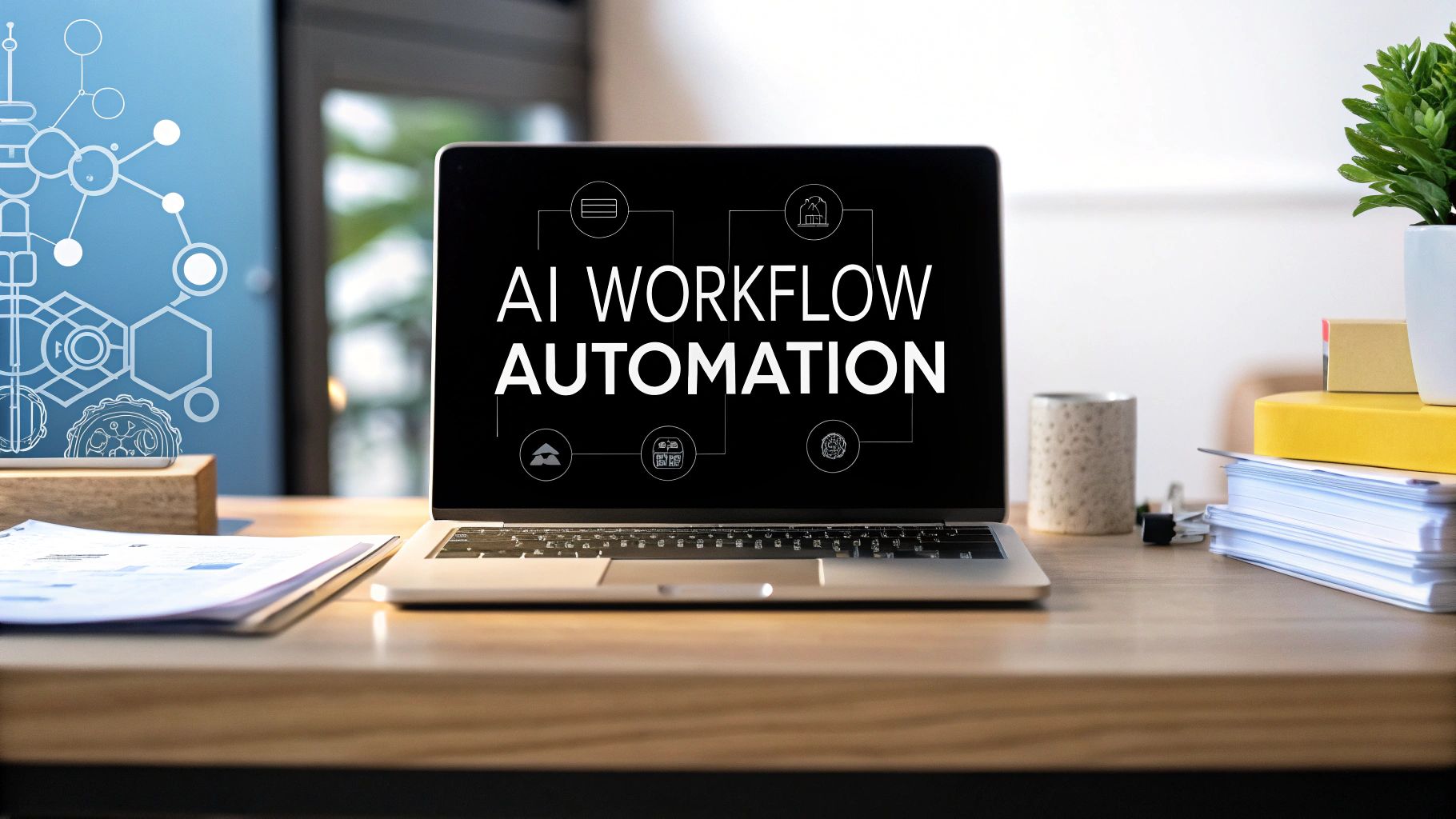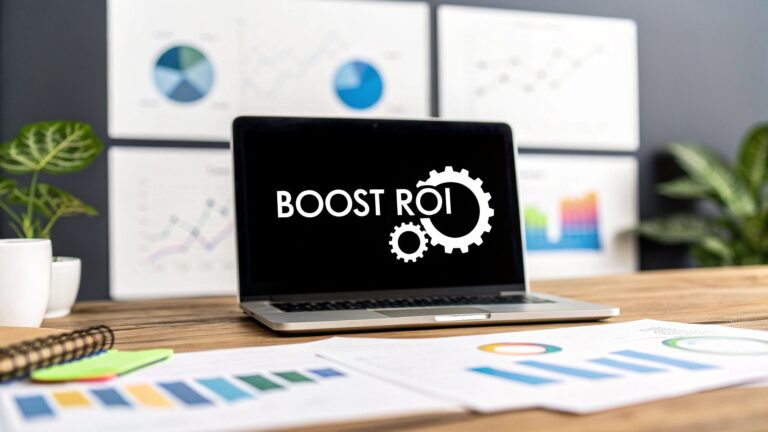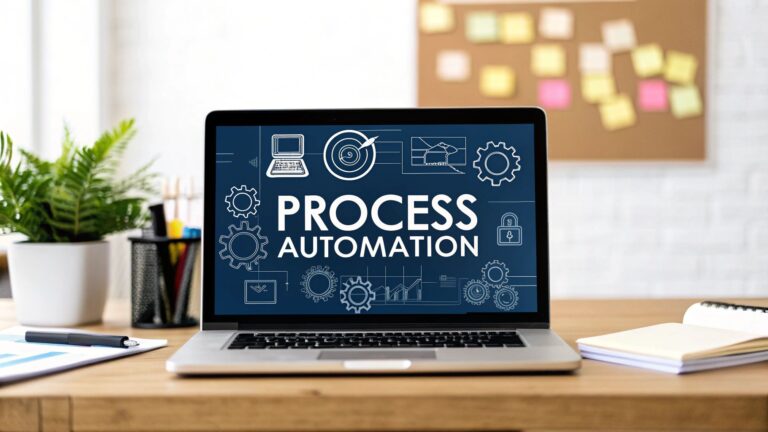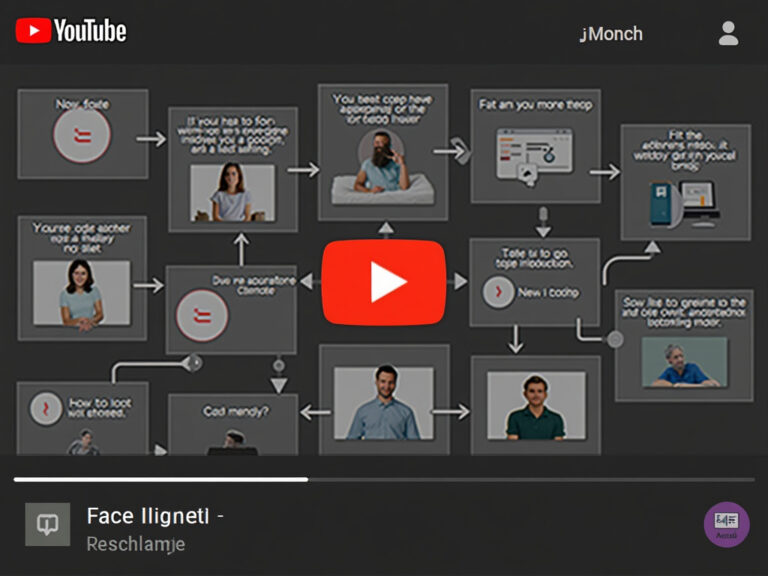Your Guide to AI Powered Workflow Automation
AI-powered workflow automation is about using artificial intelligence to not just do tasks, but to actually learn, adapt, and make decisions within your business processes. Think of it as a major upgrade from standard automation. We're moving away from simple "if this, then that" rules and into a world of dynamic, intelligent systems that can manage complex operations with very little human oversight.
The Dawn of Intelligent Business Operations

Picture your business operations changing from a manual, step-by-step assembly line into a smart factory that optimizes itself. That’s the real shift AI-powered workflow automation brings to the table. It’s not just another buzzword; it’s a genuine technological jump that embeds intelligence right into the core of how work gets done.
Standard automation is fantastic at following a script. It can perform repetitive, rule-based tasks endlessly and with perfect accuracy. But that rigidity is also its biggest flaw. The moment something unexpected happens—like an invoice with a new layout or a customer question phrased in a weird way—it hits a wall and needs a human to step in.
AI-powered systems, however, are built for the messy, unpredictable nature of the real world. They introduce a layer of learning and adaptation that turns simple task execution into truly intelligent process management.
This technology moves businesses beyond rigid 'if-this-then-that' rules. Instead, it enables systems to understand context, handle variations, and improve over time, unlocking a new level of operational agility.
From Rigid Rules to Dynamic Decisions
The real magic here is the ability to mimic human thinking. It’s not just about doing things faster; it’s about doing them smarter. This intelligent layer lets businesses achieve things that were simply out of reach before.
Just look at these key differences:
- Intelligent Data Processing: Instead of just shuffling data from one box to another, AI can actually read and make sense of unstructured information, like the text in emails, legal contracts, or customer support tickets.
- Adaptive Workflows: The system can make decisions on the fly, rerouting a task or changing its priority based on new information, all without a developer having to rewrite the code.
- Predictive Insights: By sifting through past data, AI can forecast future trends, spot potential risks in your supply chain, or even identify a high-value sales lead before a person ever sees it.
This isn't just theory—it’s driving massive market growth. The global workflow automation market was valued at USD 21.51 billion in 2024 and is expected to hit USD 37.45 billion by 2030. This boom is happening because more and more companies are adopting AI-driven platforms to get these advanced capabilities.
Securing a Competitive Edge
Getting a handle on AI automation is fast becoming non-negotiable for staying competitive. Businesses that adopt it aren't just cutting their operational costs; they're empowering their people. By taking the tedious, repetitive work off their plates, employees are freed up to focus on the strategic, creative, and high-impact tasks that actually grow the business.
To get a feel for how deeply AI is changing business, just look at its broader AI applications in digital marketing, where personalization and data analysis have completely changed how companies interact with customers. That same level of intelligence is now flowing into every other part of the business, creating smarter and more resilient organizations.
How AI Transforms Everyday Workflow Automation
Think of traditional workflow automation like a highly efficient assembly line robot. It's programmed to do one thing perfectly—move a standard-sized box from point A to point B. It’s fast and flawless. But the moment a box of a different shape or size comes along, the entire line grinds to a halt. The robot is stuck because it only knows the rules it was given. This is the classic limitation of basic automation: it’s powerful but rigid.
This is exactly where AI-powered workflow automation steps in and changes the game. Instead of just following a script, AI adds a layer of intelligence. It turns that rigid robot into an adaptable problem-solver that can think on its feet. This intelligence allows your systems to navigate the messy, unpredictable nature of real-world business without needing a human to step in at every turn.
This visual shows how an AI assistant can guide a professional through complex tasks, making sophisticated automation feel intuitive and accessible.
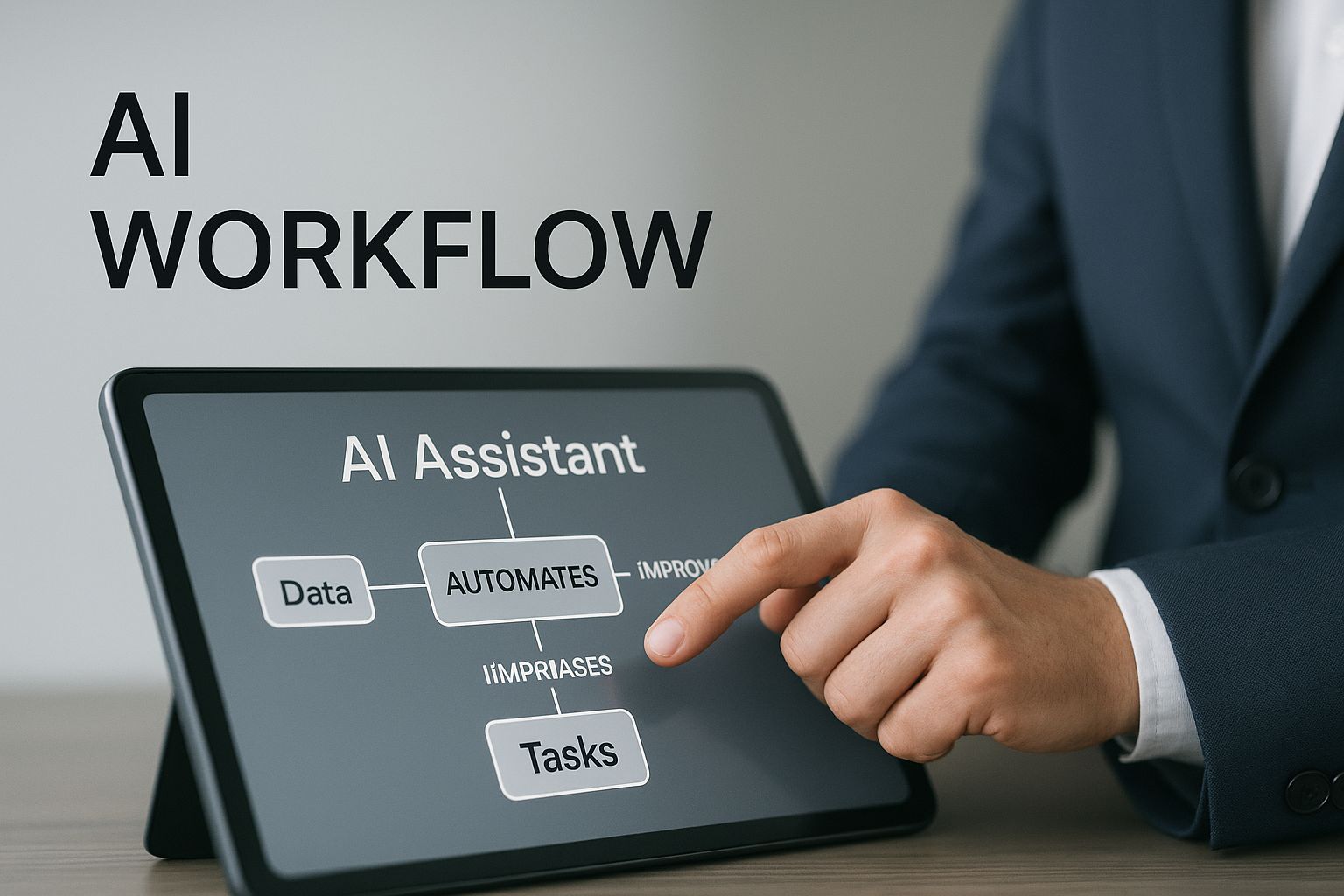
The image perfectly captures the synergy between human expertise and intelligent systems—the very heart of modern automation.
Moving Beyond Basic Rules
The jump from basic to intelligent automation is a significant one. Let's start with Robotic Process Automation (RPA). RPA is the digital version of our assembly line robot. It’s fantastic for high-volume, repetitive tasks that never change, like copying data from a spreadsheet into your CRM. If you're new to the concept, our guide on what is workflow automation is a great starting point.
But Intelligent Automation (IA) is where things get really interesting. IA takes the foundation of RPA and infuses it with AI technologies like machine learning (ML), natural language processing (NLP), and computer vision. This combination creates systems that don't just execute commands—they interpret information, learn from experience, and adapt over time.
The core difference is this: RPA follows pre-defined rules using structured data. Intelligent Automation, however, can understand and process unstructured data, handle exceptions, and learn from human corrections to improve its own performance.
An Everyday Example Unpacked
Let’s look at a process every business deals with: processing supplier invoices.
-
An RPA bot can be set up to open emails from a known supplier, find a PDF with a specific name, and pull the invoice number from the top right corner. But if a supplier sends an invoice with a new layout, the bot fails. The process breaks.
-
An AI-powered workflow approaches this much more intelligently. It uses computer vision to "read" the entire document, no matter the layout. It then uses NLP to understand the context—it knows what "Invoice #," "Total Due," and "Vendor Name" mean, even if they're in different spots on each invoice.
Crucially, if the AI is uncertain about a piece of data, it flags it for a human to review. Then, using machine learning, it remembers that correction. The next time a similar invoice comes in, it gets it right. This is the kind of adaptive capability that makes AI-driven systems so powerful. For a closer look at how this works, you can explore the ins and outs of document processing automation.
The market is taking notice of this shift in a big way. The intelligent automation market, which combines AI with automation, was valued at USD 9.1 billion in 2024. Projections show it rocketing to an incredible USD 84.2 billion by 2037.
This evolution isn't just about doing things faster. It's about building more resilient and dynamic operations. AI transforms brittle, rule-based processes into flexible workflows that can handle the unexpected, make smart predictions, and uncover valuable insights that were once buried deep within your data.
Unlocking the Tangible Benefits of AI Automation
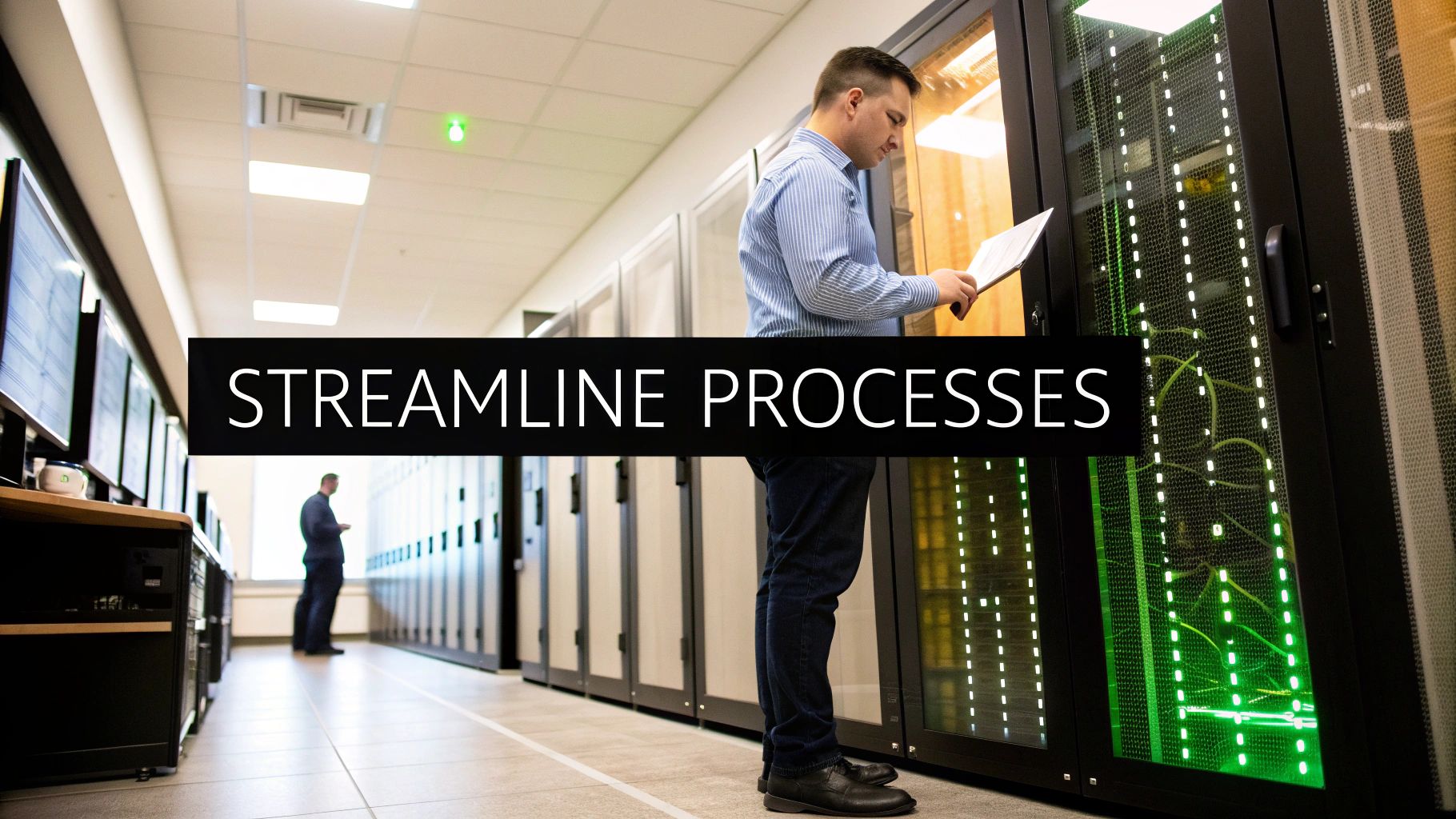
It’s one thing to understand the theory behind AI, but what really matters is the impact it has on the ground. Bringing AI-powered workflow automation into your business isn’t just a tech project; it’s a strategic move that pays real, measurable dividends across your entire operation. The benefits ripple out far beyond just getting things done faster, touching everything from your bottom line to employee satisfaction.
So, let's move past the hype and look at the concrete advantages businesses are seeing right now. These aren’t pie-in-the-sky ideas but practical outcomes that solve everyday business headaches. By automating with intelligence, you can turn operational weak spots into genuine competitive strengths.
Drastically Enhanced Efficiency
The first and most obvious win is a massive jump in efficiency. AI doesn’t just speed up a task—it executes it on a scale and at a speed that's simply not humanly possible. Think about a customer support team swamped with thousands of tickets every day. A person might get through a few per hour, carefully reading, sorting, and crafting a reply for each one.
An AI system, on the other hand, can tear through that same daily queue in minutes. It can instantly sort tickets by urgency, fire off answers to common questions, and pass only the truly tricky issues to a human agent. This frees up your team to focus on solving the high-value problems that need a human touch, rather than drowning in repetitive work.
By taking over the high-volume, repetitive work, AI automation gives your team the breathing room to focus on strategy, creative problem-solving, and building real customer relationships—the things people do best.
Significant Cost Reductions
More efficiency almost always means lower costs, but the savings go even deeper than that. A surprising amount of business expense comes from simple human error—the small mistakes that lead to big bills from rework, compliance fines, or lost customers.
An AI-driven process drastically cuts down on these mistakes. In accounting, for example, an automated workflow can check invoices against purchase orders with 100% accuracy, instantly flagging any mismatches. This stops overpayments in their tracks and keeps you compliant, saving money and reducing financial risk. The results speak for themselves: over 90% of workers report a productivity boost from automation, and businesses often see operating costs drop by an average of 22%.
To give you a clearer picture, here's a quick breakdown of how these benefits translate into tangible business outcomes.
Key Benefits of AI Workflow Automation
| Benefit Category | Description | Example Business Outcome |
|---|---|---|
| Increased Productivity | AI handles repetitive, time-consuming tasks around the clock, freeing up human workers for more strategic activities. | A marketing team automates social media scheduling and reporting, allowing them to spend more time on campaign strategy and creative development. |
| Reduced Operational Costs | Automation minimizes manual errors, reduces the need for rework, and optimizes resource allocation. | An HR department uses AI to screen resumes, reducing hiring costs and time-to-fill for open positions. |
| Improved Accuracy | AI systems follow rules precisely, eliminating the human errors common in data entry, processing, and compliance tasks. | A finance team automates invoice processing, resulting in a 99% reduction in payment errors and late fees. |
| Enhanced Decision-Making | AI analyzes large datasets to uncover insights and predict trends, enabling proactive and data-informed choices. | A retail company uses AI to forecast product demand, leading to optimized inventory levels and a 15% reduction in stockouts. |
Ultimately, each of these benefits works together to create a more resilient, agile, and profitable business.
Smarter, Data-Driven Decisions
Maybe the most powerful advantage of all is the ability to make fundamentally better decisions. AI has an incredible knack for sifting through massive amounts of data to find patterns and insights a person would never spot. This effectively turns your business's history into a roadmap for the future.
This capability is changing how entire departments operate:
- Sales Forecasting: An AI model can analyze years of sales data, market trends, and even the weather to predict future demand with startling accuracy.
- Supply Chain Management: By constantly monitoring supplier data and logistics, AI can alert you to a potential delay long before it becomes a crisis.
- Marketing Optimization: AI can score incoming leads to predict which ones are most likely to buy, helping your sales team focus their energy for the biggest return.
By leveraging AI for streamlined business automation, you move from constantly putting out fires to proactively planning your next move. This kind of data-backed foresight gives you a serious edge, helping you jump on opportunities and dodge risks before your competition knows what's happening.
AI-Powered Workflow Automation in the Real World
Theories and definitions are one thing, but the real "a-ha!" moment comes when you see how a technology actually works on the ground. When you see how AI-powered workflow automation tackles real-world business headaches, its value clicks into place. It stops being an abstract buzzword and becomes a practical tool for growth.
These stories from different industries show just how deeply AI can reshape the way companies operate, transforming manual, error-prone tasks into smart, self-driving systems. Let's dig into a few examples of how different departments are putting this tech to work.
Finance Reimagined: The End of Invoice Pile-Ups
Imagine a mid-sized logistics company drowning in a sea of invoices. Their accounts payable (AP) team was stuck in a rut, spending most of their week just keying in data from hundreds of invoices, each formatted a little differently. It was a slow, costly process riddled with human errors that led to late payment fees and unhappy suppliers.
Before Automation:
The manual workflow was a constant bottleneck. An employee would open an email, download a PDF, print it, and then meticulously type the vendor name, invoice number, line items, and total into their accounting software. One tiny typo could mean a costly overpayment or a missed due date, straining important supplier relationships. The team was always just trying to keep their heads above water, with zero time for high-value financial strategy.
After AI Automation:
They flipped the script by bringing in an AI-powered workflow. The new system keeps an eye on the AP inbox 24/7. When an invoice lands, the AI uses computer vision and natural language processing to instantly "read" the document—no matter the layout. It intelligently pulls out all the critical data and checks it against existing purchase orders.
If everything lines up, the invoice gets approved and scheduled for payment automatically. If there's a mismatch, the system flags it and sends it to the right person for a quick look. What used to take days now takes minutes. The AP team has been freed up to focus on optimizing cash flow and building much stronger partnerships with their vendors.
Human Resources Creates a Flawless First Day
A fast-growing tech startup had a different kind of problem: their new-hire onboarding was a mess. It was a chaotic tangle of emails bouncing between HR, IT, and hiring managers to get offer letters sent, laptops ordered, and orientation scheduled. Too often, a new hire’s first day was spent waiting around for system access or equipment.
"Organizations handle hundreds, if not thousands, of complex workflows that demand precise, repeatable execution. Automating these workflows has been a time-consuming process… As a result, many potentially valuable business processes remain manual, leading to inefficiencies and missed opportunities."
This insight perfectly captures why companies like this startup are making the switch.
Before Automation:
The HR coordinator was basically a human checklist, manually kicking off every single step. This meant sending out a standard offer letter, shooting an email to IT with hardware requests, and trying to juggle schedules for intro meetings. The process was full of potential delays and dropped balls, creating a pretty poor first impression for their top talent.
After AI Automation:
Now, the moment a candidate is marked as "hired" in their applicant tracking system, an AI-powered workflow springs into action. The system automatically:
- Generates and sends a personalized offer letter, pulling the details straight from the candidate’s profile.
- Creates a new user account and fires off a ticket to IT with the exact hardware and software permissions needed for the new hire's role.
- Schedules orientation and training sessions by checking the calendars of everyone involved to find the best time.
- Enrolls the new employee in the company’s payroll and benefits systems.
The result is a smooth, professional, and welcoming experience every single time. New hires feel ready to go and are productive from day one, while the HR team gets to concentrate on the more human-centric parts of their jobs.
Marketing Personalizes Campaigns at Scale
A B2C e-commerce brand wanted to graduate from generic email blasts. They knew personalization was the key to unlocking more sales, but they didn't have the team or the time to manually segment their audience and craft custom campaigns for every shopper.
Before Automation:
Their marketing team sent the same weekly newsletter to their entire list. It drove a few sales, sure, but engagement was low and the unsubscribe rate was too high. They were leaving a ton of money on the table by not speaking directly to what their customers were actually interested in.
After AI Automation:
By plugging their e-commerce platform into an AI-powered marketing automation tool, everything changed. The system now watches customer behavior in real-time—what they look at, what they add to their cart, and what they buy. Using this data, the AI workflow triggers hyper-personalized campaigns automatically.
For example, if a customer spends time looking at hiking boots but leaves without buying, the system can follow up 24 hours later with an email featuring those exact boots, along with related gear like wool socks or a waterproof jacket. This dynamic, one-to-one marketing has led to a huge jump in click-through rates and a serious boost in sales—all without the marketing team lifting a finger.
Your Blueprint for Implementing AI Automation
Jumping into AI-powered workflow automation can feel overwhelming, but it really doesn't have to be. The secret? Start small, build momentum, and celebrate the quick wins. Trying to overhaul your entire business in one go is a recipe for frustration. Instead, a thoughtful, step-by-step approach is the best way to get real results early and ensure a smooth transition.
Think of this as your practical roadmap—a guide to take you from picking your very first project to measuring its success down the road. It’s all about turning the incredible potential of AI into a day-to-day reality for your team.
Find Your Low-Hanging Fruit
First things first: you need to find the perfect starting point. The best place to begin is with a process that is both a major pain point and relatively simple to fix. You’re hunting for those "quick wins"—the tasks that eat up your team's time but are fundamentally straightforward and based on clear rules. These are your prime candidates.
To uncover these opportunities, get your team involved and ask them a few direct questions:
- What repetitive tasks do you absolutely dread doing every day? This will quickly uncover things like manual data entry, copying and pasting between apps, or pulling the same standard reports over and over.
- Where do the most common mistakes happen? Human error in invoicing, order processing, or migrating data isn't just costly; it's often a sign of manual fatigue. Automation is the perfect cure.
- Which steps are holding everything else up? If one slow, manual task is creating a bottleneck for an entire workflow, automating it can unleash a massive wave of efficiency for everyone.
By zeroing in on these areas, you can show tangible value almost immediately. A successful first project builds the confidence and buy-in you'll need to tackle more ambitious automation down the line.
Select the Right Automation Tools
Once you’ve identified a process to automate, it's time to choose your tools. The market is packed with options, and they aren't all created equal. Each one is built for different needs, budgets, and levels of technical skill. Getting this choice right is crucial.
The right platform isn't always the most powerful one—it's the one that fits your team's current skills and the specific problem you're solving. For most businesses, a user-friendly no-code tool is a much smarter start than a complex, enterprise-grade system.
To help you navigate your options, it's helpful to understand the main categories of automation platforms available.
Choosing Your Automation Approach
This table breaks down the different types of AI automation platforms to help you find the right fit for your business goals, budget, and in-house capabilities.
| Platform Type | Ideal User | Key Features | Example Use Case |
|---|---|---|---|
| No-Code Platforms | Business users, marketers, and operations managers with no coding skills. | Visual drag-and-drop interfaces, pre-built integrations, and guided workflow creation. | Automating lead nurturing sequences in a CRM based on email engagement. |
| Low-Code Platforms | Teams with some technical know-how who need more customization. | Combines visual tools with the option to add custom scripts or API calls. | Building a custom client onboarding portal that connects multiple internal systems. |
| Enterprise Solutions | Large organizations with dedicated IT departments and complex needs. | Advanced security, governance, and the ability to handle massive-scale process automation. | Automating end-to-end supply chain logistics across a global operation. |
Ultimately, a platform's value comes from its usability. For many businesses just getting started, a no-code or low-code platform like MakeAutomation provides the perfect mix of power and ease of use.
Design, Test, and Launch a Pilot Program
Whatever you do, don't roll out a brand-new automation to the entire company at once. A pilot program is your best friend here. Treat your first project like a controlled experiment, giving you the space to work out all the kinks before it goes live.
Start by mapping the entire process from start to finish. Get a clear picture of every action, decision, and potential hiccup. From there, you can build a prototype in your chosen platform. For a deeper dive into this stage, our guide on how to automate business processes walks you through it step-by-step.
Now, run a small-scale test with a single team member or a limited batch of data. This is your chance to spot problems—like an integration that doesn't quite work as planned or a logical step that needs refining. Get feedback directly from the people involved and use it to improve the workflow. This cycle of testing and tweaking is what turns a good idea into a reliable, rock-solid automation.
Monitor, Measure, and Continuously Optimize
Your work isn’t done when you hit "launch"—in many ways, it's just beginning. Once an automation is running, you need to keep a close eye on it to make sure it's actually doing its job. Great AI-powered workflow automation isn't a "set it and forget it" activity; it requires ongoing attention to deliver real value.
Set up simple dashboards to track the metrics that truly matter. These KPIs will prove its worth and can include:
- Time Saved: How many work hours are being reclaimed each week?
- Error Reduction: By what percentage have manual mistakes decreased?
- Cycle Time: How much faster is the process now from beginning to end?
- Cost Savings: What is the measurable financial impact on operational costs?
This data is your proof. It demonstrates ROI and helps you spot new opportunities for improvement. An automated process should never be static; it should evolve right along with your business. As your needs change, you can revisit and refine your workflows to make them even more efficient and impactful.
Here’s the rewritten section, designed to sound like it was written by an experienced human expert.
What’s Next for Intelligent Workflows?
The world of AI-powered workflow automation isn’t just evolving; it's accelerating. What we see today is merely the groundwork for systems that will soon operate with a level of autonomy and insight we’re only just beginning to imagine. This next wave isn't about simply automating a few tasks here and there—it's about orchestrating entire business functions.
The conversation is quickly moving toward hyperautomation, which is really just a disciplined approach to identifying and automating nearly every business process that can be automated. Picture a business where all the routine operations, from finance to customer service, are managed by a network of intelligent agents. This isn't some far-off sci-fi concept; it's the clear direction the industry is headed.
The Rise of the AI-Augmented Workforce
This future isn't about replacing people. It's about empowering them. We are stepping into the era of the AI-augmented workforce, where humans and intelligent bots work together as a single, cohesive team. In this model, AI takes care of the data-heavy lifting and mind-numbing repetition, freeing up people to focus on strategic oversight, creative problem-solving, and emotional intelligence—things humans do best.
Think about a financial analyst who no longer spends days pulling and cleaning data. Instead, they team up with an AI that prepares all the necessary information in an instant. This allows the analyst to jump straight into interpretation and strategy. It’s a powerful partnership, blending machine speed with human insight to solve complex problems more effectively than ever before.
A key development on the horizon is the ability for AI to build workflows from simple instructions. Soon, you'll be able to describe a process in plain English—or even show a screen recording of it—and have generative AI automatically map out the entire workflow for you.
This capability will completely change the game, lowering the barrier to entry so that any subject matter expert can create powerful automations without needing to write a single line of code.
From Execution to Self-Management
Looking even further ahead, the real breakthrough will be the emergence of truly autonomous processes. These are workflows that don't just execute tasks but also monitor their own performance, diagnose issues, and even fix themselves.
- Self-Healing Workflows: Imagine an AI that detects a critical API is down. Instead of waiting for a human to intervene, it could automatically switch to a backup data source to keep things running smoothly.
- Proactive Optimization: The system could analyze its own performance data, find bottlenecks, and then suggest or even implement improvements to make itself more efficient over time.
- Generative Communication: We're already seeing generative AI draft emails and reports. The next logical step is for it to manage entire communication chains, like handling a customer support ticket from the initial contact all the way through to resolution.
This shift turns AI-powered workflow automation from a tool we command into a partner that actively manages and improves business operations. For any company looking to build resilience, drive innovation, and achieve real growth in the years ahead, this evolution is critical. The time to start your automation journey isn’t tomorrow; it's right now.
Of course. Here is the rewritten section, designed to sound completely human-written and natural.
Your AI Automation Questions, Answered
Jumping into AI-powered automation can feel like a big step, and it's natural to have questions. We get it. Let's walk through some of the most common ones we hear from businesses just like yours.
What’s the Real Difference Between Standard and AI Automation?
Think of standard automation—like the older Robotic Process Automation (RPA) tools—as a very obedient but rigid assistant. It’s fantastic at following a strict set of rules for simple, repetitive tasks. If you tell it to copy data from cell A1 to B1, it will do that perfectly every time. But if that data suddenly appears in cell A2, the whole process grinds to a halt. It can’t adapt.
AI-powered automation, on the other hand, is more like a savvy team member. It doesn't just follow rules; it understands context and learns as it goes. It can read an email, figure out if it's an urgent complaint or a simple query, and then decide what to do next. This lets it tackle the kind of messy, unpredictable workflows that would completely stump a standard bot.
Do I Need to Be a Developer to Build AI Workflows?
Not anymore. While building a massive, enterprise-wide system from scratch might call for a team of developers, the game has completely changed for most businesses. A new wave of no-code and low-code platforms has made this technology accessible to just about anyone.
These tools use simple drag-and-drop interfaces, which means the people who actually know the process—your experts in marketing, HR, or operations—can build the exact automations they need. No coding required.
This is a huge shift. It empowers your subject matter experts to become the builders, turning their deep operational knowledge directly into powerful, automated solutions.
Will AI Automation Get Rid of Jobs at My Company?
The honest answer is that the goal is to elevate jobs, not eliminate them. AI is brilliant at the monotonous, high-volume tasks that people often find draining and repetitive. Think about processing thousands of invoices or sorting through endless support tickets.
By handing that work over to AI, you free up your team to focus on what humans are uniquely good at. We’re talking about high-level strategy, creative problem-solving, and building genuine relationships with customers. These are the activities that drive real value and growth, allowing your best people to work on your biggest opportunities.
Ready to stop wasting time on manual tasks and start focusing on growth? MakeAutomation provides practical frameworks and hands-on support to build the right AI automations for your business. Reclaim your team's time and see a real return on your investment. Find out how at https://makeautomation.co.

